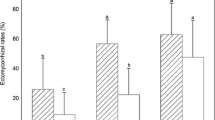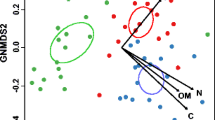Abstract
Background and aims
Dark septate endophytes of the Phialocephala fortinii s.l. – Acephala applanata species complex (PAC) are abundant root colonizers of woody plants in boreal and temperate forest ecosystems where they form complex communities. Community structure was spatially stable for 3 years in a previous experiment, suggesting PAC’s inability to disperse or mutual inhibition of neighboring PAC genotypes. The aim of this study was to test whether changes in PAC community structure occur at all.
Methods
The community structure originally determined in 2004 was reassessed in 2014 in a Norway-spruce plantation using microsatellite genotyping.
Results
Most isolates belonged to Phialocephala turicensis, P. letzii, P. europaea, and P. helvetica in both years. P. uotilensis and Acephala applanata were rare. PAC species were the same at only two grid points in both years. P. europaea was more frequent than P. turicensis in 2004 whereas the situation was opposite in 2014. Only four of the 22 genotypes in 2004 were found in 2014. Interestingly, none of the genotypes was detected at the same grid points in both years. Extended sampling in 2014 led to a significantly higher number of grid points testing positive for the presence of P. turicensis and P. helvetica.
Conclusions
More than 3 years are required to detect shifts in PAC community structures. The observed shifts suggest that PAC are able to disperse in soil or via root networks, though very slowly.



Similar content being viewed by others
References
Addy HD, Currah RS, Hambleton S (2000) Distribution and molecular characterization of the root endophyte Phialocephala fortinii along an environmental gradient in the boreal forest of Alberta. Mycol Res 104:1213–1221. doi:10.1017/S0953756200002896
Ahlich K, Sieber TN (1996) The profusion of dark septate endophytic fungi in non-ectomycorrhizal fine roots of forest trees and shrubs. New Phytol 132:259–270. doi:10.1111/j.1469-8137.1996.tb01845.x
Ahlich K, Rigling D, Holdenrieder O, Sieber TN (1998) Dark septate hyphomycetes in Swiss conifer forest soils surveyed using Norway-spruce seedlings as bait. Soil Biol Biochem 30:1069–1075. doi:10.1016/S0038-0717(97)00223-X
Ahlich-Schlegel K (1997) Vorkommen und Charakterisierung von dunklen, septierten Hyphomyceten (DSH) in Gehölzwurzeln. PhD thesis, ETH Zürich
Brenn N, Menkis A, Grünig CR et al (2008) Community structure of Phialocephala fortinii s. lat. in European tree nurseries, and assessment of the potential of the seedlings as dissemination vehicles. Mycol Res 112:650–662. doi:10.1016/j.mycres.2007.12.003
Cai L, Ji K-F, Hyde KD (2006) Variation between freshwater and terrestrial fungal communities on decaying bamboo culms. A Van Leeuw 89:293–301. doi:10.1007/s10482-005-9030-1
Currah RS, Tsuneda A (1993) Morphology and ecology of Phialocephala fortinii in roots of Rhododendron brachycarpum. Can J Bot 71:1639–1644. doi:10.1139/b93-199
Danielson RM (1991) Temporal changes and effects of amendments on the occurrence of sheating (ecto-) mycorrhizas of conifers growing in oil sands tailings and coal spoil. Agr Ecosyst Environ 35:261–281. doi:10.1016/0167-8809(91)90054-2
Fisher PJ, Petrini O (1990) A comparative study of fungal endophytes in xylem and bark of Alnus species in England and Switzerland. Mycol Res 94:313–319. doi:10.1016/S0953-7562(09)80356-0
Fukami T, Dickie IA, Wilkie JP et al (2010) Assembly history dictates ecosystem functioning: evidence from wood decomposer communities. Ecol Letters 13(6):675–684. doi:10.1111/j.1461-0248.2010.01465.x
Genney DR, Anderson IC, Alexander IJ (2006) Fine-scale distribution of pine ectomycorrhizas and their extramatrical mycelium. New Phytol 170:381–390
Gillet F, Peter M, Ayer F et al (2010) Long-term dynamics of aboveground fungal communities in a subalpine Norway spruce forest under elevated nitrogen input. Oecologia 164:499–510. doi:10.1007/s00442-010-1668-3
Graf F (1994) Ecology and sociology of macromycetes in snow-beds with Salix herbacea L. in the alpine Valley of Radönt (Grisons, Switzerland). Dissertationes Botanicae 235:1–242
Grünig CR, Sieber TN (2005) Molecular and phenotypic description of the widespread root symbiont Acephala applanata gen. et sp. nov., formerly known as dark-septate endophyte Type 1. Mycologia 97:628–640. doi:10.3852/mycologia.97.3.628
Grünig CR, Sieber TN, Holdenrieder O (2001) Characterisation of dark septate endophytic fungi (DSE) using inter-simple-sequence-repeat-anchored polymerase chain reaction (ISSR-PCR) amplification. Mycol Res 105:24–32. doi:10.1017/S0953756200003658
Grünig CR, Sieber TN, Rogers SO, Holdenrieder O (2002) Spatial distribution of dark septate endophytes in a confined forest plot. Mycol Res 106:832–840. doi:10.1017/S0953756202005968
Grünig CR, Linde CC, Sieber TN, Rogers SO (2003) Development of single-copy RFLP markers for population genetic studies of Phialocephala fortinii and closely related taxa. Mycol Res 107:1332–1341. doi:10.1017/S0953756203008669
Grünig CR, McDonald BA, Sieber TN et al (2004) Evidence for subdivision of the root-endophyte Phialocephala fortinii into cryptic species and recombination within species. Fungal Genet Biol 41:676–687. doi:10.1016/j.fgb.2004.03.004
Grünig CR, Duò A, Sieber TN (2006) Population genetic analysis of Phialocephala fortinii s.l. and Acephala applanata in two undisturbed forests in Switzerland and evidence for new cryptic species. Fungal Genet Biol 43:410–421. doi:10.1016/j.fgb.2006.01.007
Grünig CR, Brunner PC, Duò A, Sieber TN (2007) Suitability of methods for species recognition in the Phialocephala fortinii–Acephala applanata species complex using DNA analysis. Fungal Genet Biol 44:773–788. doi:10.1016/j.fgb.2006.12.008
Grünig CR, Duò A, Sieber TN, Holdenrieder O (2008a) Assignment of species rank to six reproductively isolated cryptic species of the Phialocephala fortinii s.l.-Acephala applanata species complex. Mycologia 100:47–67. doi:10.3852/mycologia.100.1.47
Grünig CR, Queloz V, Sieber TN, Holdenrieder O (2008b) Dark septate endophytes (DSE) of the Phialocephala fortinii s.l. – Acephala applanata species complex in tree roots: classification, population biology, and ecology. Botany 86:1355–1369. doi:10.1139/B08-108
Grünig CR, Queloz V, Sieber TN (2011) Structure of diversity in dark septate endophytes: from species to genes. In: Pirttilä AM, Frank AC (eds) Endophytes of forest trees. Springer Netherlands, Dordrecht, pp 3–30
Hansgate AM, Schloss PD, Hay AG, Walker LP (2005) Molecular characterization of fungal community dynamics in the initial stages of composting. FEMS Microbiol Ecol 51:209–214. doi:10.1016/j.femsec.2004.08.009
Heinonsalo J, Koskiahde I, Sen R (2007) Scots pine bait seedling performance and root colonizing ectomycorrhizal fungal community dynamics before and during the 4 years after forest clear-cut logging. Can J For Res 37:415–429. doi:10.1139/x06-213
Holdenrieder O, Sieber TN (1992) Fungal associations of serially washed healthy non-mycorrhizal roots of Picea abies. Mycol Res 96:151–156. doi:10.1016/S0953-7562(09)80932-5
Hugentobler I, Reininger V, Sieber TN (2014) Control of pathogenic PAC strains by non-pathogenic PAC strains in planta does not correlate with higher competitiveness of non-pathogenic PAC strains ex planta. Mycol Progress 13:1241–1247. 10.1007/s11557-014-0986-y
Izzo A, Agbowo J, Bruns TD (2005) Detection of plot-level changes in ectomycorrhizal communities across years in an old-growth mixed-conifer forest. New Phytol 166:619–630. doi:10.1111/j.1469-8137.2005.01354.x
Jönsson MT, Edman M, Jonsson BG (2008) Colonization and extinction patterns of wood-decaying fungi in a boreal old-growth Picea abies forest. J Ecol 96:1065–1075. doi:10.1111/j.1365-2745.2008.01411.x
Jumpponen A (1999) Spatial distribution of discrete RAPD phenotypes of a root endophytic fungus, Phialocephala fortinii, at a primary successional site on a glacier forefront. New Phytol 141:333–344. doi:10.1046/j.1469-8137.1999.00344.x
Kauserud H, Lie M, Stensrud O, Ohlson M (2005) Molecular characterization of airborne fungal spores in boreal forests of contrasting human disturbance. Mycologia 97:1215–1224. doi:10.3852/mycologia.97.6.1215
Lamour KH, Hausbeck MK (2001) Investigating the spatiotemporal genetic structure of Phytophthora capsici in Michigan. Phytopathol 91:973–980. doi:10.1094/PHYTO.2001.91.10.973
Lingfei L, Anna Y, Zhiwei Z (2005) Seasonality of arbuscular mycorrhizal symbiosis and dark septate endophytes in a grassland site in southwest China. FEMS Microbiol Ecol 54:367–373. doi:10.1016/j.femsec.2005.04.011
Maloney PE, Lynch SC, Kane SF et al (2005) Establishment of an emerging generalist pathogen in redwood forest communities. J Ecol 93:899–905. doi:10.1111/j.1365-2745.2005.01031.x
Mayerhofer MS, Kernaghan G, Harper KA (2012) The effects of fungal root endophytes on plant growth: a meta-analysis. Mycorrhiza 23:119–128. doi:10.1007/s00572-012-0456-9
Oja J, Kohout P, Tedersoo L, Kull T, Kõljalg U (2015) Temporal patterns of orchid mycorrhizal fungi in meadows and forests as revealed by 454 pyrosequencing. New Phytol 205(4):1608–1618. doi:10.1111/nph.13223
Perotto S, ActisPerino E, Perugini J, Bonfante P (1996) Molecular diversity of fungi from ericoid mycorrhizal roots. Mol Ecol 5:123–131. doi:10.1111/j.1365-294X.1996.tb00298.x
Pielou EC (1977) Mathematical ecology, 2nd edn. Wiley, New York
Piry S, Alapetite A, Cornuet J-M et al (2004) GENECLASS2: a software for genetic assignment and first-generation migrant detection. J Hered 95:536–539. doi:10.1093/jhered/esh074
Queloz V, Grünig CR, Sieber TN, Holdenrieder O (2005) Monitoring the spatial and temporal dynamics of a community of the tree-root endophyte Phialocephala fortinii s.l. New Phytol 168:651–660. doi:10.1111/j.1469-8137.2005.01529.x
Queloz V, Duò A, Grünig CR (2008) Isolation and characterization of microsatellite markers for the tree-root endophytes Phialocephala subalpina and Phialocephala fortinii s.s. Mol Ecol Res 8:1322–1325. doi:10.1111/j.1755-0998.2008.02279.x
Queloz V, Duò A, Sieber TN, Grünig CR (2010) Microsatellite size homoplasies and null alleles do not affect species diagnosis and population genetic analysis in a fungal species complex. Mol Ecol Resour 10:348–367. doi:10.1111/j.1755-0998.2009.02757.x
Queloz V, Sieber TN, Holdenrieder O et al (2011) No biogeographical pattern for a root-associated fungal species complex. Global Ecol Biogeogr 20:160–169. doi:10.1111/j.1466-8238.2010.00589.x
Rayner ADM, Todd NK (1980) Population and community structure and dynamics of fungi in decaying wood. In: Adv Bot Res Volume 7. Elsevier, pp 333–420
Reininger V, Sieber TN (2012) Mycorrhiza reduces adverse effects of dark septate endophytes (DSE) on growth of conifers. PLoS ONE 7, e42865. doi:10.1371/journal.pone.0042865
Reininger V, Grünig CR, Sieber TN (2012) Host species and strain combination determine growth reduction of spruce and birch seedlings colonized by root associated dark septate endophytes. Environ Microbiol 14(4):1064–1076. doi:10.1111/j.1462-2920.2011.02686.x
Rodriguez RJ, White JF Jr, Arnold AE, Redman RS (2009) Fungal endophytes: diversity and functional roles. New Phytol 182:314–330. doi:10.1111/j.1469-8137.2009.02773.x
Ruotsalainen A, Väre H, Vestberg M (2002) Seasonality of root fungal colonization in low-alpine herbs. Mycorrhiza 12:29–36. doi:10.1007/s00572-001-0145-6
Sieber TN (2002) Fungal Root Endophytes. In: Waisel Y, Eshel A, Kafkafi U (eds) Plant Roots - The Hidden Half, 3rd edn. Marcel Dekker, New York, pp 887–917
Sieber TN, Grünig CR (2013) Fungal Root Endophytes. In: Eshel A, Beeckman T (eds) Plant Roots - The Hidden Half, 4th edn. CRC Press, Taylor & Francis Group, Boca Raton, pp 38.31–38.49
Sieber-Canavesi F, Sieber TN (1993) Successional patterns of fungal communities in needles of European silver fir (Abies alba Mill.). New Phytol 125:149–161. doi:10.1111/j.1469-8137.1993.tb03873.x
Stahel WA (2008) Statistische Datenanalyse, 5th edn. Vieweg + Teubner, Wiesbaden
Stoyke G, Egger KN, Currah RS (1992) Characterization of sterile endophytic fungi from the mycorrhizae of subalpine plants. Can J Bot 70:2009–2016. 10.1139/b92-250
Trüssel D (2011) Zur Verbreitungsbiologie von Phialocephala subalpina, P. fortinii s.s. und Acephala applanata - Vegetative Ausbreitung im Boden. MSc thesis, ETH Zürich
Turner SD, Friese CF (1998) Plant-mycorrhizal community dynamics associated with a moisture gradient within a rehabilitated prairie fen. Restor Ecol 6:44–51. doi:10.1046/j.1526-100x.1998.00616.x
Visser S (1995) Ectomycorrhizal fungal succession in jack pine stands following wildfire. New Phytol 129:389–401. doi:10.1111/j.1469-8137.1995.tb04309.x
Walker A-S, Gladieux P, Decognet V et al (2015) Population structure and temporal maintenance of the multihost fungal pathogen Botrytis cinerea: causes and implications for disease management. Environ Microbiol 17(4):1261–1274. doi:10.1111/1462-2920.12563
Wang CJK, Wilcox HE (1985) New Species of ectomycorrhizal and pseudomycorrhizal fungi: Phialophora finlandia, Chloridium paucisporum, and Phialocephala fortinii. Mycologia 77:951–958
Zaffarano PL, Duò A, Grünig CR (2010) Characterization of the mating type (MAT) locus in the Phialocephala fortinii s.l. – Acephala applanata species complex. Fungal Gen Biol 47:761–772. doi:10.1016/j.fgb.2010.06.001
Zaffarano PL, Queloz V, Duò A, Grünig CR (2011) Sex in the PAC: a hidden affair in dark septate endophytes? BMC Evol Biol 11:282. doi:10.1186/1471-2148-11-282
Acknowledgments
We would like to thank the Genetic Diversity Centre (GDC) of ETH Zürich for providing the laboratory facilities necessary for performing microsatellite analyses. Moreover, we extend our gratitude to Anja Gall for her excellent technical assistance and Vivanne Dubach for helping with the sampling. Furthermore, we wish to thank Christine Syrad for manuscript proofreading and linguistic corrections and two anonymous reviewers for valuable input towards the improvement of the manuscript.
Author information
Authors and Affiliations
Corresponding author
Additional information
Responsible Editor: Thom W. Kuyper.
Rights and permissions
About this article
Cite this article
Stroheker, S., Queloz, V. & Sieber, T.N. Spatial and temporal dynamics in the Phialocephala fortinii s.l. – Acephala applanata species complex (PAC). Plant Soil 407, 231–241 (2016). https://doi.org/10.1007/s11104-015-2790-0
Received:
Accepted:
Published:
Issue Date:
DOI: https://doi.org/10.1007/s11104-015-2790-0




